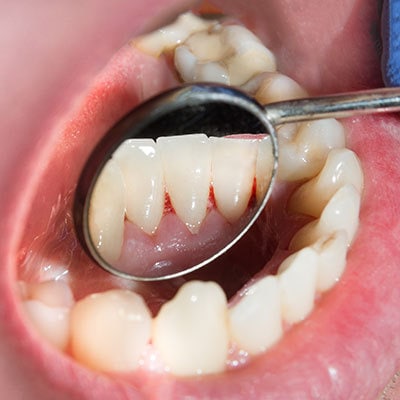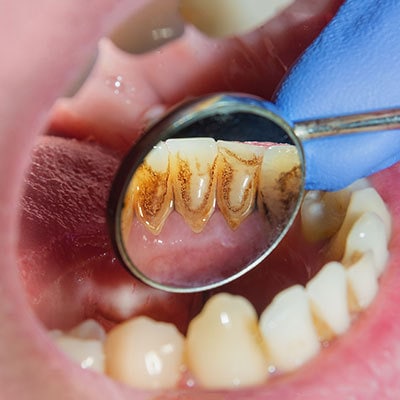Symptoms of Gum Disease
The gingiva, or what we refer to as the gums, is the tissue around the base of the teeth. Healthy gums are pale pink and fit tightly around the teeth. Good oral hygiene and regular dental examinations will help to maintain oral health and, if problems develop, detect them in the early stage to prevent future more serious problems. There are a number of symptoms which may indicate early gum disease.

Halitosis (bad breath)
Bad breath can happen anytime thanks to the hundreds of types of bad breath-causing bacteria that naturally live in the mouth. When you eat, bacteria feed on the food left in your mouth and leave a foul-smelling waste product behind. However, bad breath that just won’t go away or a constant bad taste in your mouth can be a warning sign of advanced gum disease, which is caused by sticky, cavity-causing bacteria called biofilm plaque.
Other causes of halitosis include:
- Dry Mouth - Saliva works constantly to keep the mouth clean and, if you don’t produce enough saliva, bacteria are not washed away. Other causes of dry mouth are certain medications, salivary gland problems, or breathing through your mouth.
- Food – Many foods, such as garlic and onions, can produce bad breath.
- Smoking and Tobacco - Smoking stains your teeth, gives you bad breath, and puts you at risk for a host of health problems. Tobacco users are more likely to suffer from gum disease.
- Medical Conditions - Mouth infections can cause bad breath. However, if your dentist has ruled out other causes and you brush and floss daily, your bad breath could be the result of another problem, such as a sinus condition, gastric reflux, diabetes, liver or kidney disease. In this case, see your healthcare provider.

Red, swollen, tender or Bleeding gums
Although there are numerous non-gum-related causes, an oral infection is the most common cause of bleeding gums. Many people consider bleeding gums as simply a fact of life and fail to recognize that they may be an indication of an oral infection that, left untreated, could eventually lead to tooth loss.

Biofilm plaque build-up
This is a sticky colorless deposit at first, but when it forms tartar, it is often brown or pale yellow. It is commonly found on all surfaces of the teeth and along the gumline or below the margins of the gumline. If ignored, the plaque becomes hardened and leads to gingivitis, inflammation at the gumline.
Symptoms of Gum Disease
Regular dental check-ups and good oral hygiene could prevent gum disease from progressing to the most serious stages, known as gingivitis and periodontitis. Some of the symptoms are similar for both diseases but are typically much more severe for periodontitis.
Gingivitis
- Swollen and/or tender gums
- Red gums
- Gums that bleed easily when brushed or flossed
- Bad breath
- Receding gums
Periodontitis
- Receding gums
- Swollen or puffy gums
- Bright red, dusky red or purplish gums
- Gums that feel tender when touched
- Gums that bleed easily
- Gums that pull away from the teeth (recede), making the teeth look longer than normal
- New spaces developing between the teeth
- Pus between the teeth and gums
- Bad breath
- Loose teeth
- Painful chewing
- A change in the way the teeth fit together when biting
At this stage, treatment is imperative. Left untreated, tooth loss most likely will occur, putting a person at risk for poor nutrition, certain systemic conditions, and possible social discomfort.
To read more about the symptoms of gum disease, visit:
- https://www.nidcr.nih.gov/health-info/gum-disease/more-info
- https://www.healthline.com/symptom/bleeding-gums
